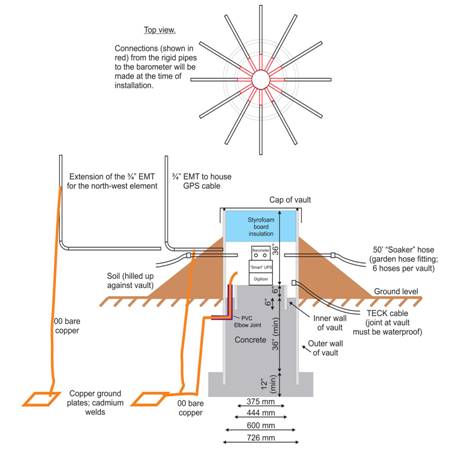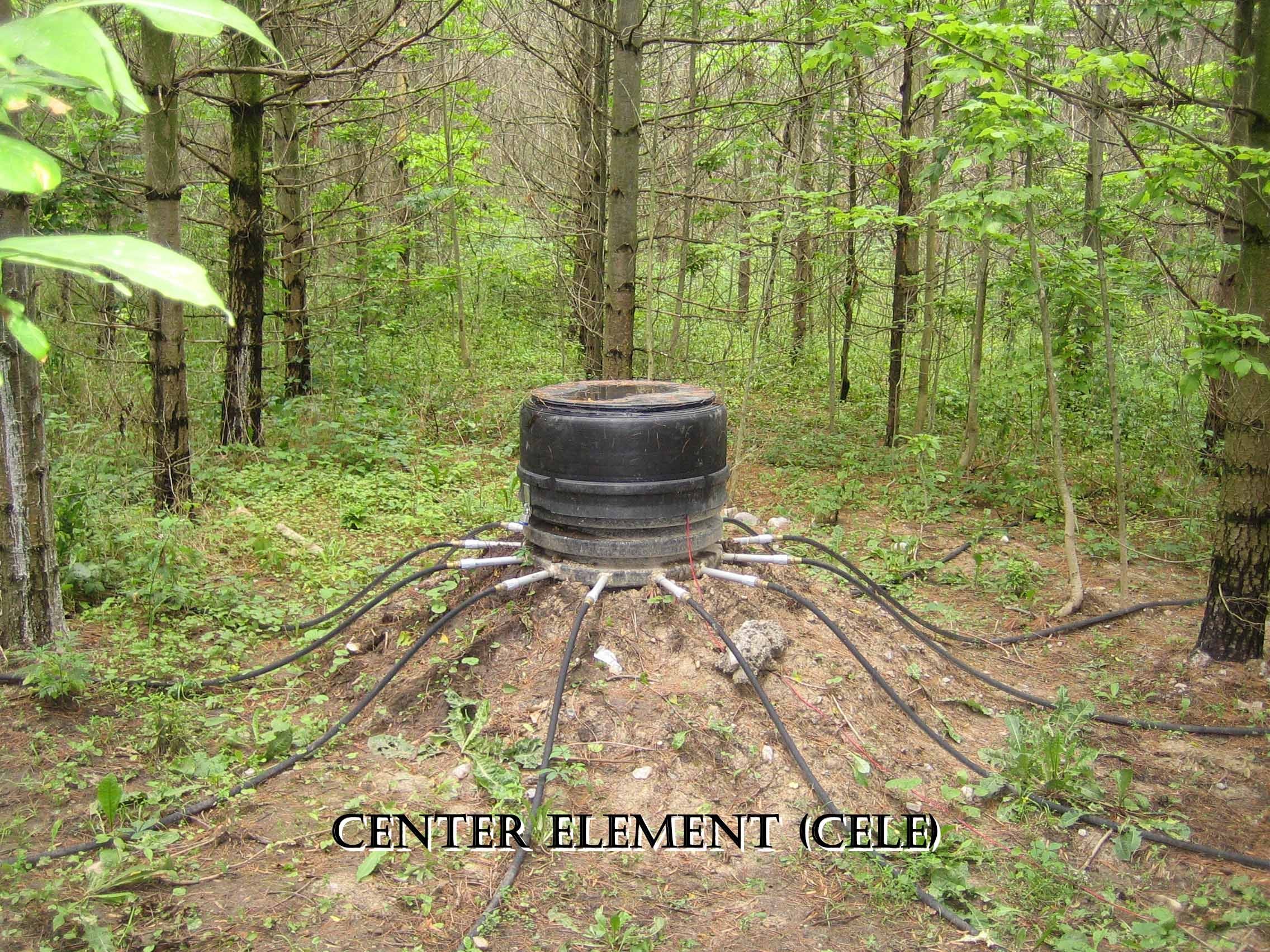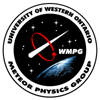The UWO Meteor Infrasound Group
Infrasonic Observations of Fireballs
Any shock generating mechanism in the atmosphere can generate infrasonic waves (low range propagation of low frequency sound waves; f ~ 0.02 - 20 Hz). Events can be detected as perturbations in density, temperature, particle velocity, or pressure (SNR best in pressure relative to atmosphere). Infrasound has been proven to be a reliable means of detecting bolides and can be used to obtain an estimate of bolide energy, location, event time, and source height.
The Elginfield Infrasound Array is a cooperative project between the University of Western Ontario (UWO) and the Seismology Division of Natural Resources Canada (NRCan). Work began on the deployment of the array on July 5, 2005. Final installation of microphones and beginning of test bed data began January 25, 2006. Photos from the installation can be viewed here. The album will be updated as the work progresses [Album last updated: Aug. 23, 2005].
The Wind Shelter
_______________________________________________
- Robust, cost effective technology for detection of blast waves from bolides
- Experience in operations and analysis from nuclear work (from the late 1950s to 1972, USAF operated an infrasonic nuclear explosion monitoring network)
- Can distinguish meteors that interact explosively with the lower atmosphere from those that produce shock waves at higher altitudes
- Nominal detection of kiloton explosions at 2000-3000 km ranges
- Global coverage for megaton explosions
- Detections at multiple stations can provide bolide locations
- Detections can be combined with seismic, hydro-acoustic and satellite detections for more complete characterization
- Automatic processing with analyst review
Vault Materials and Construction
7’ x 24” Sewer Pipe
3’ Concrete Base
¾” PVC Tubing
00 Copper Wire & Grounding Plates
12 – 50’ long 5/8” Garden Soaker Hose
24 – Male brass hose fittings
Styrofoam insulation
12’ 4 x 4
Dirt
The vaults built to house the microbarometer sensors at each of the four elements of the Elginfield array, were designed to ensure that the equipment inside remained within a watertight environment. Because of the thick tree cover and large amount of rain and spring runoff the area receives annually a “light” above ground design was favoured over the more traditional buried concrete vaults. At each location, the sewer pipe was buried 3 ½ feet into a 6” concrete base. The pipe was then filled to ground level with concrete and a 6” high pillar placed centrally, to provide both a heat sink for the hot summer months and a measure of safety from any water that may find its way inside the vault. 00 Copper grounding wire has been fed through PVC tubing buried within the concrete and fed to the exterior of the vault to a buried grounding plate. TECK cable and GPS cable ports are fed through the sides of the vault and sealed with silicone (GPS antennas are grounded separately) and provide DC power, communication and timing information to the microphone, digitizer & battery backup within the vault. The twelve acoustic inlet ports are made of PVC tubing and brass hose fittings and are connected to twelve 50’ long porous soaker hose. Styrofoam insulation is placed inside to fill the remaining space above the instrument package, while the vault is capped with a specially designed lid made to fit snugly over the pipe. Finally to provide an extra amount of thermal insulation, the vault is half buried under a mound of the local soil. (Below: Schematic diagram of the vault)

Microbarometer Sensors
The Elginfield array uses four Chaparral Physics (Division of the Geophysical Institute of the


Chaparral Physics Model 2.5 Differential Microbarometers (Side/Top Views)
__________________________________________________________

The Elginfield infrasound array is located in the woodland region that surrounds the Elginfield Observatory (green areas in above map). The forest was originally planted more then 40 years ago to provide a means of blocking the light produced by the city
The Elginfield infrasound array went online on January 25th, 2006 with the purpose of working in tandem with observations at the IMS Infrasound array I10CA located in Lac du Bonnet,
12 inch sample length of the TECK cable used at the Elginfield Infrasound Array.

________________________________________________________




__________________________________________________________
The wind shelter was built in August 2007 and is located at the Northwest Element.
__________________________________________________________
-
Bolide Energy Yield Using Infrasound Observations
Goal: to derive an empirical method by which one can obtain bolide yields using observed infrasound measurements
Method: by looking at signals from events that have been observed by both infrasound and satellite sensors (minimum range to source: ~250 km), determine maximum signal amplitude, peak to peak amplitude, period at max. amplitude, integrated signal energy, and integrated signal energy signal to noise
Conclusions: calibrated curves created from the results will allow event yield estimates to be determined solely from observed infrasound signals in the future; effects of wind are slight; bolide curve is somewhat lower than those of nuclear/chemical explosions
Future Work: use results and relations to put limits on current theoretical predictions; improve the curves with more data; apply similar treatment to seismic observations of bolides by looking at air to ground coupling
___________________________________________________________
-
Observations of the Norwegian Fireball of June 7th, 2006 can be found here.
-
The Trajectory, Orbit, and Acoustical Analysis of the Park Forest Fireball
Abstract can be found here. Video footage and more information on the Park Forest event can be found here. - Observations of the March 5, 2006 event can be fnd here.
___________________________________________________________
Edwards, W. N., Brown, P. and ReVelle, D.O. (200
Bolide Energy Estimates from Infrasonic Measurements
W.N. Edwards, P.G. Brown and D.O. ReVelle (2005) Earth, Moon and Planets, doi: 10.1007/s11038-005-2244-4. Paper (pdf) available here.
Meteoritic dust from the atmospheric disintegration of a large meteoroid
A.R. Klekociuk, P.G. Brown, D.W. Pack, D.O. ReVelle, W.N. Edwards, R.E. Spalding, E. Tagliaferri, B.B. and Yoo, J. Zagari (2005) Nature, 436, pp. 1132 – 1135. Paper (pdf) available here.
The Villalbeto de la Pena meteorite fall:
J. Llorca, J.M. Trigo-Rodriguez, J.L. Ortiz. J.A. Docobo, J. Garcia-Guinea, A.J. Castro-Tirado, A.E. Rubin, O. Eugster, W.N. Edwards, M. Laubenstein, and I. Casanova (2005) Meteoritics and Planetary Science, 40, pp.795 – 804. Paper (pdf) available here.
Genesis – An Artificial, low velocity “meteor” fall and recovery: September 8, 2004
D.O. ReVelle, W.N. Edwards ad T.D. Sandoval (2005) Meteoritics and Planetary Science, 40, pp. 895 – 916. Paper (pdf) available here.
The orbit, atmospheric dynamics, and initial mass of the
P. Brown, D. Pack, W.N. Edwards, D.O. ReVelle, B.B. Yoo, R.E. Spalding and E. Tagliaferri (2004) Meteoritics and Planetary Science, 39, pp.1781 – 1796. Paper (pdf) available here. Video footage and more information on the
Entry Dynamics and acoustics/infrasonic/seismic analysis for the Neuschwanstein meteorite fall
ReVelle, D.O., Brown, P.G., and P. Spurny (2004) Meteoritics and Planetary Science,39, 1605-1625. pdf available here.
The Moravka meteorite fall:2. Interpretation of infrasonic and seismic data
Brown, P.G, Kalenda, P., ReVelle, D.O. and Borovicka, J. (2003) Meteoritics and Planetary Science, 38, 989-1003.
The Flux of Small Near-Earth Objects colliding with the Earth
Brown, P. R.E. Spalding, D.O. ReVelle, E. Tagliaferri, S.P. Worden, (2002) Nature, 420, 294-296
An entry model for the
Brown, P, ReVelle, D.O., Tagliaferri, E. and A. Hildebrand., (2002) Meteoritics and Planetary Science, 37, No. 5, 661-677. pdf available here.
Multi-Station Infrasonic Observations of Two Large Bolides: Signal Interpretation and Implications for Monitoring of Atmospheric Explosions
Brown, P., Whitaker, R.W. and ReVelle, D.O. and E. Tagliaferri., (2002) Geophysical Research Letters, 29 (13), 1-4. pdf available here.


